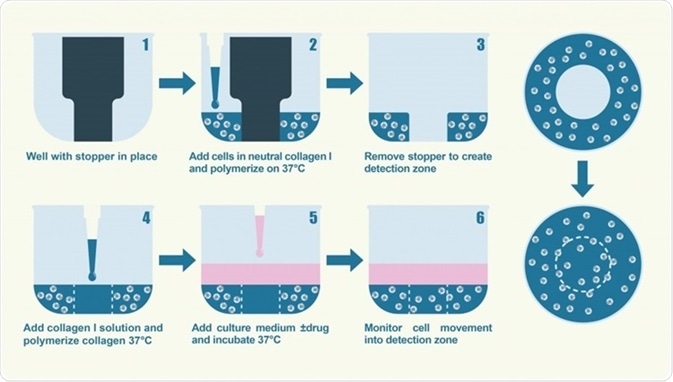Cell movement between locations, usually in response to a mechanical or chemical signal, is known as cellular migration. It is essential for an extremely wide variety of organic processes, from ongoing biological maintenance (i.e., tissue repair) to developmental (i.e., embryogenesis).
It is possible to measure the net migration and rate of migration for cellular populations in vitro by utilizing a cell migration assay. This helps the user to gain an understanding of numerous bioorganic mechanisms.
In order to study various bioorganic processes, Platypus Technologies provides powerful cell migration assays.
The cell exclusion-zone migration assays have real-time monitoring capabilities and high flexibility so that they adhere to the stringent requirements of expert users in numerous application areas, from pharmaceuticals to academia.
This article will outline the basic principles of cell migration assays in more detail, with a focus on exclusion-zone technologies.

Image Credit: Platypus Technologies, LLC
Cell Migration Assays: Basic Working Principles
Generic cell-based assays are employed to analyze and quantify various cellular functions, which include cell signaling and proliferation. The suitable assay is determined by specific test objectives and the application.
For example, studies into metastasis usually employ a Boyden Chamber to monitor the adhesion of invading cells to a semi-permeable membrane seeded with an extracellular matrix (ECM) protein mixture prior to detaching cells from the plate well with a suitable buffer and quantifying the total number of cells present.
This configuration is ideal for screening the efficacy of pharmacological compounds in cancer treatment and for evaluating the migration of tumor cells into healthy tissue via degradation of extracellular macromolecules.
Also known as the transwell assay, the conventional Boyden Chamber has benefits and drawbacks. It is a well-established analytical technique and so it is easy to implement at comparatively low costs. Yet, migration results can conflict with invasion data as in vitro transwell models have poor physiological relevance.

Side view of Oris™ 3D Embedded Cell Invasion assay plate throughout the assay setup. Image Credit: Platypus Technologies, LLC
Another popular method that is used to quantify the rate of/net total cellular migration is cell exclusion migration. It is performed by creating a cell-free zone in a sample well and seeding the area around this circular area with sample cells. A removable physical stopper or a soluble gel may be used to create the exclusion zone, depending on the technique.
The gel dissolves, or the physical stopper is removed to enable cell migration into the exclusion zone after the seed cells have adhered to the well. High throughput screening tools are then employed to look at the detection zones as cells from the periphery migrate inwards.
Cell Exclusion-Zone Migration Assays from Platypus Technologies
The exclusion-zone technique is ideal for identifying cell migration inhibitors and promoters in drug discovery, cancer research and wound healing applications, to name a few. Platypus Technologies have used their expertise for the development of advanced exclusion-zone cell migration assays for the highest possible quality results.
Instead of the exclusive end-point analysis associated with transwell technology, Platypus Technologies strives for the acquisition of real-time data collection in terms of cell migration versus time. Their high-performance cell migration assays are created to give the user total confidence in their results.

This information has been sourced, reviewed and adapted from materials provided by Platypus Technologies, LLC.
For more information on this source, please visit Platypus Technologies, LLC.